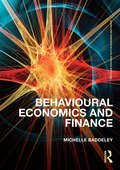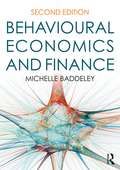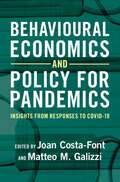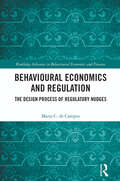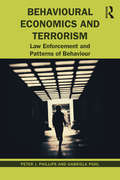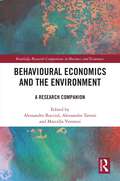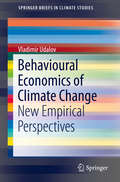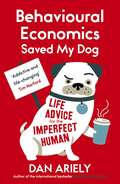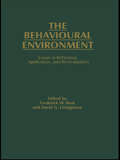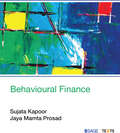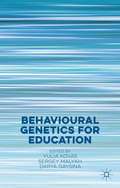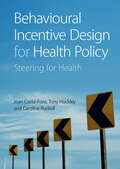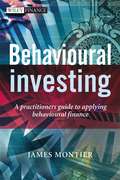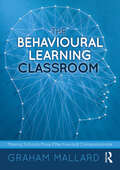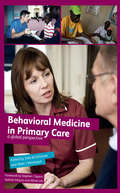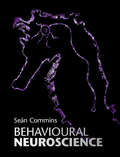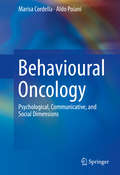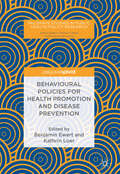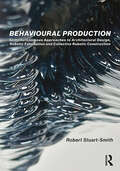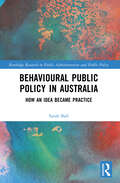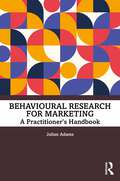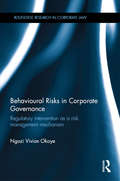- Table View
- List View
Behavioural Economics and Finance
by Michelle BaddeleyStandard models in economics and finance usually assume that people are rational, self-interested maximisers, effectively co-ordinated via the invisible hand of the price mechanism. Whilst these approaches produce tractable, simple models, they cannot fully capture the uncertainties and instabilities that affect everyday choices in today’s complex world. Insights from the other social and behavioural sciences can help to fill the gap and behavioural economics is the subject which brings economics and finance together with psychology, neuroscience and sociology. Behavioural Economics and Finance introduces the reader to some of the key concepts and insights from this rich, inter-disciplinary approach to real-world decision-making.
Behavioural Economics and Finance (Routledge Advanced Texts In Economics And Finance Ser.)
by Michelle BaddeleyBehavioural economics and behavioural finance are rapidly expanding fields that are continually growing in prominence. While orthodox economic models are built upon restrictive and simplifying assumptions about rational choice and efficient markets, behavioural economics offers a robust alternative using insights and evidence that rest more easily with our understanding of how real people think, choose and decide. This insightful textbook introduces the key concepts from this rich, interdisciplinary approach to real-world decision-making. This new edition of Behavioural Economics and Finance is a thorough extension of the first edition, including updates to the key chapters on prospect theory; heuristics and bias; time and planning; sociality and identity; bad habits; personality, moods and emotions; behavioural macroeconomics; and well-being and happiness. It also includes a number of new chapters dedicated to the themes of incentives and motivations, behavioural public policy and emotional trading. Using pedagogical features such as chapter summaries and revision questions to enhance reader engagement, this text successfully blends economic theories with cutting-edge multidisciplinary insights. This second edition will be indispensable to anyone interested in how behavioural economics and finance can inform our understanding of consumers’ and businesses’ decisions and choices. It will appeal especially to undergraduate and graduate students but also to academic researchers, public policy-makers and anyone interested in deepening their understanding of how economics, psychology and sociology interact in driving our everyday decision-making.
Behavioural Economics and Regulation: The Design Process of Regulatory Nudges (Routledge Advances in Behavioural Economics and Finance)
by Maria C. de CamposIn recent years, the idea of "nudges" – small changes in individual choice architecture that do not involve incentives or coercion – has entered policy discourse and practice to address various problems ranging from energy usage to retirement savings. However, how nudges can be incorporated into regulatory practice, and whether the experimental methodologies used to design nudges are still appropriate when they are being used as a regulatory instrument is still an unexplored issue. As this book shows, the translation of ideas into the world of regulation is not so simple and straightforward. By analysing the different experimental alternatives that regulators can use when designing nudges and through a close analysis of a real-world example – the case of the European Union tobacco warnings – this book proposes an alternative design process more in tune with the reality of regulation. The book explores the implications of iterative experimental methodologies and processes for regulators, concluding with a call for an alternative nudging’s design process tailored to the regulatory space. This book is crucial for researchers and policy-makers interested in the incorporation of nudging into regulation and anyone interested in the implications of behavioural economics – and evidence more generally – for regulatory design.
Behavioural Economics and Terrorism: Law Enforcement and Patterns of Behaviour
by Peter J. Phillips Gabriela PohlBehavioural Economics and Terrorism can be used as a guide to help us think about thinking and, in doing so, to appreciate the deep quirkiness of human behaviour. Each day, people draw on their understanding of human behaviour. This takes place subconsciously for the most part but as situations become more complex it becomes necessary to think more deliberately about how people make their decisions. This book can be used to better understand human action in such contexts. In the high-stakes world of counter-terrorism, every angle of advantage is critical. From terrorists’ operational choices to the way that information flows through intelligence agencies, the book explains the patterns of behaviour that systematically shape human decision-making, for good and for bad. Decision-makers’ use of reference points, their loss aversion, overconfidence, goals and aspirations all shape their choices under conditions of risk and uncertainty. This book helps to shed light on how to use these concepts (and more) to develop deeper insights into the way in which terrorists think about their attack methods and targets.
Behavioural Economics and the Environment: A Research Companion (Routledge Research Companions in Business and Economics)
by Alessandro BucciolHumans have long neglected to fully consider the impact of their behaviour on the environment. From excessive consumption of fossil fuels and natural resources to pollution, waste disposal, and, in more recent years, climate change, most people and institutions lack a clear understanding of the environmental consequences of their actions. The new field of behavioural environmental economics seeks to address this by applying the framework of behavioural economics to environmental issues, thereby rationalizing unexplained puzzles and providing a more realistic account of individual behaviour. This book provides a complete and rigorous overview of environmental topics that may be addressed and, in many instances, better understood by integrating a behavioural approach. This volume features state-of-the-art research on this topic by influential scholars in behavioural and environmental economics, focussing on the effects of psychological, social and cognitive factors on the decision-making process. It presents research performed using different methods and data collection mechanisms (e.g. laboratory experiments, field experiments, natural experiments, online surveys) on a variety of environmental topics (e.g. sustainability, natural resources). This book is a comprehensive and innovative tool for researchers and students interested in the behavioural economics of the environment and in the design of policy interventions aimed at reducing the human impact on the environment.
Behavioural Economics of Climate Change: New Empirical Perspectives (Springerbriefs In Climate Studies)
by Vladimir UdalovThis book investigates various kinds of climate change mitigation behaviour, which range from a general support of environmental policy to concrete energy-saving activities, in selected countries. Drawing on extensive national and international survey data, the analysis has the following main objectives: to identify potential determinants of individuals’ renewable energy support, and to analyse the impact of experiences with natural disasters on individuals’ choice between economic growth and environmental protection. Moreover, it examines the role of environmental motivations behind direct daily energy-saving behaviour. The empirical results reveal that various types of climate change mitigation behaviour are not only driven by a mixture of environmental and non-environmental/economic motivations but also depend on external circumstances such as natural disasters. Since CO2 emission dynamics stem to some extent from the choices people make every day in their roles as consumers, investors and citizens, the new findings presented are also valuable from a policy perspective.
Behavioural Economics Saved My Dog: Life Advice For The Imperfect Human
by Dan ArielySunday Times bestselling author Dan Ariely brings his unique perspective to bear on a maelstrom of life's problems - from how to deal with a Christmas card list that's fast becoming unmanageable to whether or not you should have children.Ariely changed the way we view ourselves, how we think and how we act, with his book Predictably Irrational. In his immensely popular Wall Street Journal advice column, where readers "Ask Ariely" for his help with various dilemmas, he provides a logical view on the seemingly illogical, shedding light on the most curious minutiae of human behaviour.With a helping hand from legendary New Yorker cartoonist William Haefeli, Ariely's new book will make you laugh at the ridiculous aspects of our daily existence just as you gain a new perspective on how to handle the inevitable challenges that life brings us all.
The Behavioural Environment: Essays in Reflection, Application and Re-evaluation
by Frederick W. Boal David N. LivingstonePlacing human action and perception at the centre of the subject, this book considers the effects of mankind on the environment, drawing particularly from William Kirk's work on the behavioural environment model. Reviewing Kirk's original model in light of recent ideological debate and extensive new evidence, this collection of essays from leading names in the field shows that a behavioural approach is essential in understanding human geography and man's relationship with the ecological environment.
Behavioural Finance
by Sujata Kapoor Jaya Mamta ProsadA comprehensive and well-structured textbook that provides a concrete foundation of the most essential elements of behavioural finance and related biases in a simple manner. Designed as a core textbook for the students of finance, Behavioural Finance discusses the theoretical concepts of investment behaviour in the dynamic environment of financial markets. It explains the role and impact of psychological biases and sociological influences underlying the financial behaviour of both individual and institutional investors. Through the use of case studies and real-life examples, primarily from emerging economies like India, the book explores the psychology of individual investors and market experts such as financial analysts and portfolio managers. It discusses how key market players make decisions and shows that every behavioural inconsistency can cumulate to market anomalies. The highlight of this book is the inclusion of contemporary issues such as the role of weather, emotional state of mind, religion and culture in investment decisions and the emphasis on upcoming areas in this discipline such as neurofinance and emotional finance. Key Features • Focuses on both past and contemporary research findings to simplify theories and concepts • Provides psychological insights to investors and practitioners to identify their biases in financial decision-making process • Module-based chapterization for better understanding of concepts
Behavioural Genetics for Education
by Yulia Kovas Sergey Malykh Darya GaysinaEducational environments interact with children's unique genetic profiles, leading to wide individual differences in learning ability, motivation, and achievement in different academic subjects – even when children study with the same teacher, attend the same school and follow the same curriculum. This book considers how education can benefit from the recent progress in genetically informative research. The book provides new insights into the origins of individual differences in education traits such as cognitive abilities and disabilities; motivation and personality; behavioural and emotional problems; social functioning; well-being, and academic achievement. Written and edited by international interdisciplinary experts, this book will be of interest to teachers, parents, educational and developmental psychologists, policy makers and researchers in different fields working on educationally-relevant issues.
Behavioural Incentive Design for Health Policy: Steering for Health
by Joan Costa-Font Tony Hockley Caroline RudisillBehavioural economics has become a popular way of tackling a broad range of issues in public policy. By presenting a more descriptive and possibly accurate representation of human behaviour than traditional economics, Behavioural Incentive Design for Health Policy tries to make sense of decisions that follow a wider conception of welfare, influenced by social norms and narratives, pro-social motivations and choice architectures which were generally neglected by standard economics. The authors show how this model can be applied to tackle a wide range of issues in public health, including smoking, the obesity crisis, exercise uptake, alcoholism, preventive screenings and attitudes towards vaccinations. It shows not only how behavioural economics allows us to better understand such challenges, but also how it can design effective incentives for addressing them. This book is an extensive reassessment of the interaction between behavioural incentives and health.
Behavioural Insights Team (A)
by Michael Luca Patrick RooneyThe Behavioural Insights Team case introduces students to the concept of choice architecture and the value of experimental methods (sometimes called A/B testing) within organizational contexts. The exercise provides an opportunity for students to apply these principles to solve a managerial problem - increasing tax compliance rates among delinquent taxpayers. Students are asked to rewrite the letter that the UK tax department (HMRC) sends to delinquent taxpayers; this exercise is based on a successful behavioral field experiment run by the UK government.
Behavioural Investing
by James MontierBehavioural investing seeks to bridge the gap between psychology and investing. All too many investors are unaware of the mental pitfalls that await them. Even once we are aware of our biases, we must recognise that knowledge does not equal behaviour. The solution lies is designing and adopting an investment process that is at least partially robust to behavioural decision-making errors. Behavioural Investing: A Practitioner's Guide to Applying Behavioural Finance explores the biases we face, the way in which they show up in the investment process, and urges readers to adopt an empirically based sceptical approach to investing. This book is unique in combining insights from the field of applied psychology with a through understanding of the investment problem. The content is practitioner focused throughout and will be essential reading for any investment professional looking to improve their investing behaviour to maximise returns. Key features include: The only book to cover the applications of behavioural finance An executive summary for every chapter with key points highlighted at the chapter start Information on the key behavioural biases of professional investors, including The seven sins of fund management, Investment myth busting, and The Tao of investing Practical examples showing how using a psychologically inspired model can improve on standard, common practice valuation tools Written by an internationally renowned expert in the field of behavioural finance
The Behavioural Learning Classroom: Making Schools More Effective and Compassionate
by Graham MallardTeachers are virtually never taught how learners make decisions about studying, concentration and participation, and are not able to find this in educational literature. The Behavioural Learning Classroom breaks new ground, allowing teachers to harness their students’ traits and quirks to produce a more effective and compassionate classroom. Important lessons from behavioural science Optimising lesson design Effective (home)work Marking and feedback Rewards and sanctions The physical environment of the classroom Pupil behaviour Designing behavioural experiments and analysing data Supported by fundamental findings in behavioural science, this book provides practical, accessible, tried and tested techniques to improve the mental wellbeing of pupils and teachers alike. It is an enjoyable and accessible read for any teacher or school leader who wants to enhance their pupils’ experience of learning.
Behavioural Medicine in Primary Care: A Global Perspective (Radcliffe Ser.)
by Julie M Schirmer Alain J MontegutThis textbook provides strategies for primary health professionals to apply behavioral medicine principles and concepts. Many behavioral medicine textbooks assume a Western care model, where providers receive behavioral health training and have access to behavioral medicine specialists. However, in many international practice care environments providers receive minimal behavioral medicine training, specialists are unavailable, and patients originate from many cultures and ethnic backgrounds. Behavioral Medicine in Primary Care recognizes this, enabling physicians, social workers and others unfamiliar with behavioral medicine to meet the mental and behavioral health needs of their patients. Its focus on patients from multiple settings and cultures and its comprehensive, practical format illustrate skills that can be applied immediately wherever care is being provided. It is aimed at everyone seeing patients for primary healthcare purposes, including physicians, assistant physicians, nurses, midwives, social workers, or healthcare workers in community health sites, private clinics, or in patients' homes. 'A practical, very readable manualA". Wherever you practice or teach primary medical care around the globe, this book will help you provide better care to your patients.' Stephen J. Spann, in his Foreword 'Application of the principles advocated by Behavioral Medicine in Primary Care will make a difference to patient outcomes, whatever country or continent that they live in.' Gabriel Ivbijaro, in his Foreword An invaluable resource for those who dare to take on the challenge of initiating behavioral change in their patients using principles and strategies proven effective in multiple countries and cultures Alfred Loh, in his Foreword
Behavioural Neuroscience
by Seán ComminsBrain and behaviour are intrinsically linked. Animals demonstrate a huge and complex repertoire of behaviours, so how can specific behaviours be mapped onto the complicated neural circuits of the brain?<P><P> Highlighting the extraordinary advances that have been made in the field of behavioural neuroscience over recent decades, this book examines how behaviours can be understood in terms of their neural mechanisms. Each chapter outlines the components of a particular behaviour, discussing laboratory techniques, the key brain structures involved, and the underpinning cellular and molecular mechanisms.<P> Commins covers a range of topics including learning in a simple invertebrate, fear conditioning, taste aversion, sound localization, and echolocation in bats, as well as more complex behaviours, such as language development, spatial navigation and circadian rhythms. Demonstrating key processes through clear, step-by-step explanations and numerous illustrations, this will be valuable reading for students of zoology, animal behaviour, psychology, and neuroscience.<P> Provides an introduction to brain, behaviour and neurons, drawing on examples from a wide range of behaviours and species from the simplest organisms to humans.<P> Offers step-by-step explanations of the mechanisms underlying various behaviours, helping students to understand complex neural processes.<P> A summary box at the end of each chapter poses open questions, stimulating further interest and encouraging readers to think about where their research might go next.
Behavioural Oncology: Psychological, Communicative, and Social Dimensions
by Aldo Poiani Marisa CordellaMedical, educational, and public health efforts have reduced the spread of many major diseases, yet cancer perseveres, in spite of continuing research and improvements in practice. Especially promising among therapeutic strategies are ones that recognise patients as individuals with thoughts, feelings--and speech. Rooted in deep understanding of the mutual relationship between behavior and cancer, Behavioural Oncology combines extensive clinical wisdom and empirical data to illuminate the psychological, social, and existential aspects of cancer, and to offer a framework for empathic, patient-centered care. Chapters delve into the psychobiology of long-term illness, examining stress, pain, fatigue, sensory and sleep disturbances, and other quality of life issues as well as considerations of age, gender, culture, and comorbidity. The book's emphasis on linguistic and communicative aspects of cancer--and practical skills from respecting patient narratives to delivering bad news--adds necessary depth to concepts of the therapeutic relationship. In this way, the authors warn about overmedicalizing cases to the point of losing patient identity. Major areas of the coverage include: Biology and behavior in cancer prevention and suppression. The psychology of cancer patients: emotions, cognition, and personality Social dimensions, including stigma, coping, and social support Language, communication, and cross-cultural issues Existential, spiritual, and end-of-life concerns Doctor-patient relationships The psychological benefits of complementary therapies Bringing new scope and substance to familiar mind/body constructs, Behavioural Oncology is a definitive reference for a spectrum of healthcare professionals, among them health and clinical psychologists, oncologists and family physicians, oncology nurses, and clinical social workers. Its discussion questions and summaries make it a suitable text for undergraduate and graduate courses in related topics.
Behavioural Policies for Health Promotion and Disease Prevention (Palgrave Studies in Public Health Policy Research)
by Benjamin Ewert Kathrin LoerPolicy-making in public health is highly complex, which is one reason why the behavioural turn is now playing a significant role in this field. Against this backdrop, this book aims to develop a theoretical understanding of how policymakers take up public health challenges and how policies change over the course of time. Accordingly, the book reveals policy-makers' underlying assumptions, which influence the way in which public policy seeks to promote the health status of citizens. In a second step, the book presents a typology of policy instruments and applies this to the field of health promotion. This typology introduces an option that adds behaviourally informed insights to the toolbox of political analysis. Empirical evidence of behavioural health policies can be found in various countries around the world, and the book presents both relevant country studies and examples from the supra- and international level. Finally, the book discusses the implications of the rise of behavioural health policies, proposes a specific concept of health citizenship and reviews state-citizen relations. The book is useful for academics from health-related disciplines, such as political science, sociology, and public health, as well as for policy-makers, practitioners and students.
Behavioural Production: Semi-Autonomous Approaches to Architectural Design, Robotic Fabrication and Collective Robotic Construction
by Robert Stuart-SmithAutonomous manufacturing and cyber-physical systems are key enabling technologies of the Fourth Industrial Revolution (IR4) which are currently being incorporated into the building design and construction industries. These emerging IR4 technologies have the potential to effectively improve construction affordability and productivity, address current and future building demand, and reduce the environmental impact of the built environment. However, design approaches that make use of IR4 technologies are still relatively unexplored. While automation, such as mass production, promotes standardised design solutions, design thinking that embraces varying degrees of autonomy can lead to unique and considered approaches to design on an industrial scale.Behavioural Production: Semi-Autonomous Approaches to Architectural Design, Robotic Fabrication and Collective Robotic Construction explores design operating through the orchestration of spatiotemporal events. A multi-agent behaviour-based approach to computation is employed in architectural design and extended to individual and swarm-based robotic methods for additive manufacturing. Behavioural Production seeks to expand our capacity to engage with the world at large through varying degrees of autonomy. In an industrialised world where traditional craftsmanship has been marginalised and cannot scale to meet societal needs, this book speculates a means to bring scalable forms of creativity into the act of making. This is explored through the use of materials, generative algorithms, computer vision, machine learning, and robot systems as active agents in design conception and realisation. The book presents a collection of ideas, projects, and methods developed in the author’s design practices and research labs in the fields of architecture and computer science. This body of work demonstrates that engaging with semi-autonomous processes does not diminish authorship, but rather expands it into new forms of design agency that seamlessly integrate with emerging manufacturing and construction technologies whilst authoring distinctive design character.
Behavioural Public Policy
by Adam OliverHow can individuals best be encouraged to take more responsibility for their well-being and their environment or to behave more ethically in their business transactions? Across the world, governments are showing a growing interest in using behavioural economic research to inform the design of nudges which, some suggest, might encourage citizens to adopt beneficial patterns of behaviour. In this fascinating collection, leading academic economists, psychologists and philosophers reflect on how behavioural economic findings can be used to help inform the design of policy initiatives in the areas of health, education, the environment, personal finances and worker remuneration. Each chapter is accompanied by a shorter 'response' that provides critical commentary and an alternative perspective. This accessible book will interest academic researchers, graduate students and policy-makers across a range of disciplinary perspectives.
Behavioural Public Policy in Australia: How an Idea Became Practice (Public Administration and Public Policy)
by Sarah BallUsing rich ethnographic data and first-hand experience, Ball presents a detailed account of Australia’s attempts to incorporate behavioural insights into its public policy. Ball identifies three competing interpretations of behavioural public policy, and how these interpretations have influenced the use of this approach in practice. The first sees the process as an opportunity to introduce more rigorous evidence. The second interpretation focuses on increasing compliance, cost savings and cutting red tape. The last focuses on the opportunity to better involve citizens in policy design. These interpretations demonstrate different ‘solutions’ to a series of dilemmas that the Australian Public Service, and others, have confronted in the last 50 years, including growing politicisation, technocracy and a disconnect from the needs of citizens. Ball offers a detailed account of how these priorities have shaped how behavioural insights have been implemented in policy-making, as well as reflecting on the challenges facing policy work more broadly. An essential read for practitioners and scholars of policy-making, especially in Australia.
Behavioural Research for Marketing: A Practitioner's Handbook
by Julian AdamsThis book, the first of its kind, provides market researchers and marketeers with the tools to better understand human behaviour by drawing upon social science theory from different schools of thought, including sociology, psychology and behavioural economics. It has practical examples throughout to help illustrate how to operationalise theory in market research and to underpin the way we understand how people think, behave, decide and make choices. Each theory is explained in accessible terms to ensure that the content is relevant and useful to commercial market researchers. By considering different theoretical models of human behaviour from the outset, this book will open new avenues of investigation, help researchers to develop more dynamic and challenging hypotheses to test during the research process, and ultimately result in more insightful outcomes. The book brings together theories that look at how society is shaped and formed, and how this impacts on the individual, along with theories that focus on the mind and behaviour of the individual; these perspectives are equally important in market research but not usually considered within the same text. This book is not limited to theory alone; in each chapter, illustrative examples are used to help demonstrate how theory can be applied to real-world market research projects. Additionally, throughout there are helpful suggestions in terms of question content to help operationalise theory. This book will appeal to those that have recently entered the field of market research and are interested in the theoretical underpinnings of human behaviour, undergraduates and post-graduates that are studying marketing, business studies or social science, where a core component of the course requirement is market research, and finally those that are users of market research data and want a working knowledge of key theories of human behaviour.
Behavioural Risks in Corporate Governance: Regulatory Intervention as a Risk Management Mechanism (Routledge Research in Corporate Law)
by Ngozi Vivian OkoyeRecent cases of corporate failures, including the fixing of LIBOR rates and money laundering issues in the banking industry, highlight how behavioural issues on the part of company directors are significant contributory factors in corporate governance and the success or failure of companies. This book examines how personality and behavioural issues have contributed to major corporate failures, and how this risk may be managed. The book examines behavioural risks in corporate governance, and evaluates the extent to which risk management mechanisms have acknowledged various aspects of behaviour. Drawing from cases in the UK, the US and Australia and research in psychology and the behavioural sciences, Ngozi Vivian Okoye argues that current corporate governance mechanisms lack provision for identifying and managing personality risks, and suggests how constituent elements of behaviour should be engaged with when developing preventive mechanisms for corporate failures. Okoye presents a conceptual framework for identifying and managing personality risks, and explores how personality risk may be built into corporate governance regulation. The book will be of great use and interest to researchers and practitioners in business and company law, corporate governance, and critical management studies.
